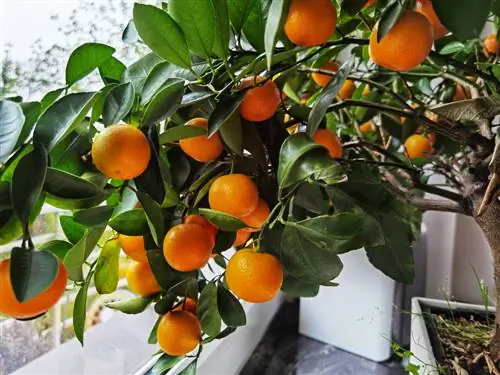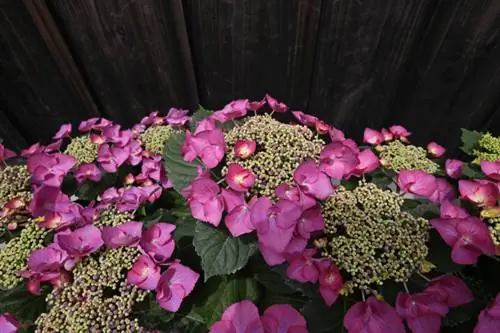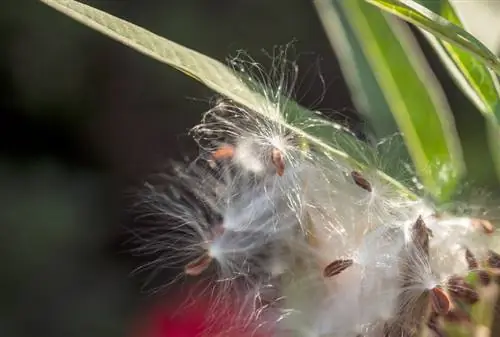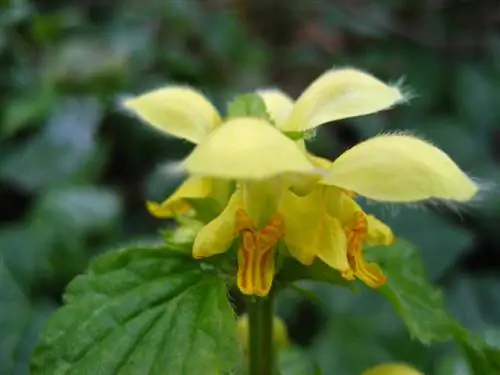- Author admin [email protected].
- Public 2023-12-16 16:46.
- Last modified 2025-06-01 06:02.
Read the profile here to find out whether a Calamondin bears edible fruit with information about flowering and ripening times. This is how you properly care for and overwinter an orange tree.
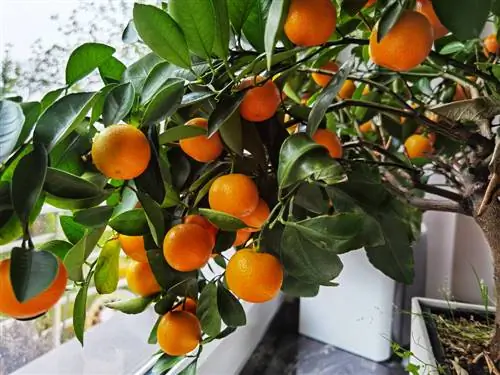
Are Calamondin fruits edible and what do they taste like?
Calamondin fruits are edible and taste sweet and sour, depending on their ripeness. Green fruits are bitter, while yellow fruits taste sour and orange fruits are refreshingly sweet and sour. The fruits ripen in winter and are rich in vitamin C, calcium, iron and phosphorus.
Profile
- Scientific name: Citrus mitis syn. Citrofortunella microcarpa
- Genus: Citrus plants (Citrus)
- Synonyms: orange tree, dwarf orange, calamondin orange
- Origin: Asia
- Growth type: evergreen tree
- Growth height: 100 cm to 200 cm
- Flowering period: April to June
- Fruit: Berry
- Fruit properties: edible
- Ripening time: winter
- Taste: sour
- Winter hardiness: not hardy
Fruit
Calamondin is a natural cross between the citrus plants kumquat (Fortunella margarita) and mandarin (Citrus reticulata). The natural hybrid was discovered in China. From a botanical point of view, the common commercial names orange tree, dwarf orange or calamondine orange are misleading. A look at the properties makes it clear why the calamondin fruit is not a real orange:
- Fruit properties: Fruit and peel edible
- Size: 2cm to 3cm
- Color: green (unripe), yellowish (half ripe), orange (ripe)
- Ripening period: in winter or spring
- Consistency: juicy with seeds
- Ingredients: Vitamin C, calcium, iron, phosphorus
Taste
The degree of ripeness of a calamondin orange determines its taste. The color of the shell provides an important clue:
- Green peel: inedible bitter-tart-sour
- Yellow peel: sour with a slight hint of sweetness
- Orange peel: refreshing sweet and sour
In the following video you can experience a taste test by amateur gardener pope Detlef Römisch with the active support of the parrot Coco:
Video: Calamondin in the taste test at Detlef Römisch
Flowering time
During the main flowering period in spring, a calamondin shines with a white, fragrant sea of flowers. The 2 centimeter large flowers sit singly or in clusters in the leaf axils, where they contrast picturesquely with the dark green leaves. Sometimes the flowering period shifts to summer, autumn or winter, depending on vitality and overwintering. With a little luck, the trees will be decorated with flowers, green, yellow and orange fruits at the same time.
Investing in refined Citrus mitis is worth it, because these orange trees bloom and bear fruit from the first year. Specimens grown from cuttings will torture you for four long years until they bloom for the first time.
Planting Calamondin
Calamondin are cultivated as pot plants in our latitudes. In this way, the frost-sensitive trees can easily overwinter indoors. The right combination of species-appropriate substrate, precisely fitting container and optimal location are the basis for a magnificent Calamondin. The following sections explain important details:
Mix substrate
An airy, loose soil is the best protection against harmful waterlogging. Calamondin grow very slowly and stay in the same container for years. This requires a structurally stable substrate that does not collapse. Commercially available substrates for citrus plants cannot always guarantee this premise. By mixing the substrate yourself, you can be on the safe side. This is how it works:
- 4 parts citrus soil without peat
- 1 part coconut soil as a peat substitute
- 1 part lava granules or expanded clay
- 1 part quartz sand
As an organic starting fertilizer, ideally add a handful of horn shavings to cover the high nitrogen requirements.
Plant in a pot
The right pot offers the root ball one to two finger-widths of space up to the edge. If the container is too large, your Calamondin will primarily focus on increasing the growth of its roots and neglect further branching with leaves and flowers. A hole in the bottom of the pot is mandatory for water drainage. A light-colored planter that reflects the sun's rays is recommended so that the roots do not overheat in summer. This is how you plant the orange tree correctly:
- Cover the bottom of the vessel thinly with expanded clay as drainage against waterlogging
- Fill in the substrate to half the height of the pot
- Make a hollow with your fist or flower shovel
- Unpotting Calamondin
- Place the root ball in the hollow
- Important: 3-5 cm distance between the root ball surface and the edge of the pot as a watering edge
While holding the plant upright with one hand, fill the cavities with substrate with the other hand. In the final step of planting, water the calamondin until the saucer fills up. Please throw away the excess water.
Location
Like all citrus plants, your Calamondin wants a bright location all year round. As a houseplant, the sun worshiper is in good hands in a south-facing window or in a heated winter garden. A Citrus mitis likes to spend the frost-free season on the sunny balcony. The more sunlight hits the tree, the more lush its robe of leaves, flowers and fruits.
Excursus
Ideal beginner plant
Purchasing a Calamondin in the supermarket marks the start of a successful career as a citrus plant gardener. The natural hybrid is not as squeamish as a lemon or orange tree. The little tree is good-natured and forgives many a beginner's mistake and continues to show off its lush green leaves, fragrant flowers and colorful fruits.
Care for Calamondin
Calamondin dwarf oranges are among the easiest-care citrus plants north of the Alps. Indoor gardeners love the trees because they can overwinter in living rooms. The water and nutrient supply can be achieved even without a green thumb. In contrast to the real orange tree, pruning care is simple and uncomplicated. Take a look at the following sections and you will know exactly how to properly care for a Calamondin:
Pouring
During the growth phase, your Calamondin proves to be a swallowing woodpecker. The sunnier the location, the higher the water requirement. Important questions receive a compact answer here:
- What water quality?: either with rainwater or tap water.
- When to water?: When the substrate on the surface has dried to a depth of 1 cm (finger test).
- How to water?: Water thoroughly until the saucer fills up.
- What time of day?: Water Calamondin in the morning or evening, but never in direct sunlight.
Because waterlogging kills even the easiest-care citrus plants, we recommend using a moisture meter (€39.00 at Amazon). The simple tool works with a probe that you insert into the substrate. A scale shows whether your Calamondin wants to be watered or not.
Fertilize
The summer growth phase is characterized by a high need for nitrogen and potassium as well as other nutrients. A special citrus fertilizer has the perfect composition. A liquid fertilizer can be administered effectively. Add this to the irrigation water from March to November according to the manufacturer's instructions.
Wintering
You can overwinter a Calamondin like a lemon tree. Overwintering in the apartment is possible, although it is the second best option. All options are summarized in the following overview:
- Winter in a cool place: bright at 3° to 10° Celsius in the winter garden, stairwell or garden house with frost monitor
- Winter warmly: sunny on the south window, illuminate for an additional 4 to 6 hours a day at less than 1000 lux
- Care: water more sparingly, do not fertilize from December to February (fertilize every 4 weeks at half concentration if you are staying indoors over the winter)
When you put away a Calamondin depends on its winter quarters. If the tree spends the cold season indoors, you should bring the plant in early enough so that there is no abrupt change in temperature from cold to warm. If you have to offer your Calamondin a cool winter quarters, only put it away shortly before the first frost.
Cutting
You don't have to cut a slow-growing Calamondin every year. Vitality and shape benefit from moderate pruning at intervals of two to three years. How to cut correctly:
- The best time is in early spring before budding
- Thimout dead branches at the beginning
- Cut back broken and unfavorably growing branches
- Cutting a short distance from a leaf or bud
You can trim isolated, overly long shoots at any time. Use bypass scissors as a cutting tool, the blades of which you have previously disinfected with alcohol.
Calamondin is losing leaves - what to do?
Despite its reputation as one of the easiest citrus plants to care for, a calamondin is not immune to leaf loss. This is not a cause for concern if you are aware of the following causes and countermeasures:
| Cause | What to do? |
|---|---|
| Lack of light in summer | Change location to a full sunny spot |
| Lack of light in winter | wait until the next shoot |
| Drought stress | Dip root ball in water |
| Waterlogging | repotting, cutting off rotten roots |
| Nutrient Deficiency | Administer nitrogen-rich citrus fertilizer |
Repotting
Every two to three years the substrate in the bucket is leached out. Now you should repot your Calamondin in fresh substrate, even if the roots do not completely fill the container. Please take this opportunity to take a close look at the root ball. Cut off stunted, diseased or rotten, soft roots with a sharp, disinfected knife.
Popular varieties
The Calamondin hybrid, which emerged naturally in China, is the progenitor of numerous beautiful varieties:
- Foliis Variegatis: variegated, very rare variety with yellow-white-green variegated leaves.
- Mezzo: green-leaved Calamondin, grafted on a 70 cm to 90 cm high trunk.
- Piccolo: distinctive dwarf orange Citrus mitis as a 60 cm high tree.
- Molto Grande: stately Calamondin orange tree in a 40 cm container with a height of 170 cm.
FAQ
Can you eat calamondin with the peel on?
Yes, the peel of a calamondin fruit is edible. In contrast to real oranges, you can taste the very thin peel without worry. It is recommended to consume calamondin with peel from your own harvest or organic cultivation, which is guaranteed not to have been treated with chemical agents.
Do you have a recipe suggestion for Calamondin jam?
To prepare a refreshing jam with a sour-fruity taste, you need 1 kilogram of fruit, 500 grams of preserving sugar (2:1) and screw-top jars. The peeled calamondin oranges are pureed in a large kettle. Now mix the preserving sugar into the fruit puree. Bring the mixture to the boil, stirring repeatedly, and let everything simmer gently for 5 minutes. Pour the hot Calamondin jam into the clean jars. Tightly closed, turn each jam jar upside down to cool.
Can I grow a new orange tree from a cutting?
You can grow a new Calamondin from a cutting. Before the growth phase begins, cut off an annual branch tip with three to five buds. The lower half is defoliated. Dip the cut site in rooting powder and plant the cutting in loose, well-moistened potting soil. However, the young plant thrives as a shrub. Calamondin orange trees from specialist retailers are grafted onto a robust trunk as a base.

